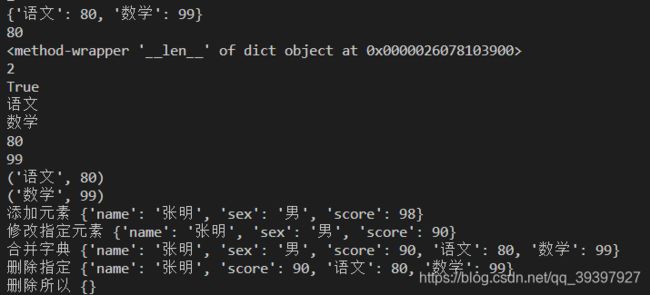神经网络与深度学习——TensorFlow2.0实战(笔记)(四)(python字典和集合)
字典和集合
字典
每个字典元素都是一个键(关键字)/值(关键字对应的取值)对
#创建字典
dic_score={"语文":80,"数学":99}
#打印
print(dic_score)
print(dic_score["语文"])
#长度
print(dic_score.__len__)#错误写法
print(len(dic_score))
#存在判断是否存在 in
print("语文" in dic_score)
"""
keys()返回字典中所有关键字
values()返回字典中所有值
items()返回字典中所有键值对
"""
#遍历
for key in dic_score.keys():
print(key)
for value in dic_score.values():
print(value)
for item in dic_score.items():
print(item)
"""
字典中的各个元素是无序的,因此每次显示的顺序可能不同
添加元素 赋值语句
修改指定元素 赋值语句
合并字典 字典.update(字典)
删除字典 pop(指定元素的关键字) 删除所有元素clear() del语句
"""
dic_student={'name':'张明','sex':'男'}
#添加
dic_student['score']=98
print("添加元素",dic_student)
#修改
dic_student['score']=90
print("修改指定元素",dic_student)
#合并
dic_student.update(dic_score)
print("合并字典",dic_student)
#删除指定
dic_student.pop("sex")
print("删除指定",dic_student)
#删除所以
dic_student.clear()
print("删除所以",dic_student)集合
集合:一组无序排列的元素组成,因此不能通过下标来访问
可变集合:创建后可以添加、修改和删除其中的元素
不可变集合:创建后就不能再改变了
#创建
set12={1,2}
print(set12)
print(len(set12))
#可变集合
set_python=set("python")
print(set_python)
#不可变集合
frozenset_python=frozenset("python")
print(frozenset_python)课程链接:https://www.icourse163.org/course/XUST-1206363802?tid=1206674203
个人公众号
![]()

